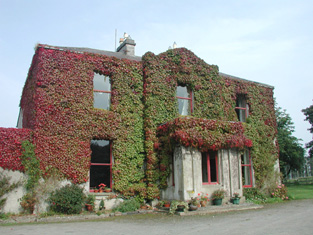Strandhill House
Houses within 5km of this house
Displaying 11 houses.
Houses within 5km of Strandhill House
Displaying 11 houses.
| House name | Description | |
|---|---|---|
| Seafield or Lisheen | At the time of Griffiths Valuation, William Phibbs owned a house at Lisheenacooravan valued at £55. This house was known as Seafield or Lisheen at different times. In 1906 Seafield/Lisheen was valued at £55. The property is now a ruin |

|
| Culleenamore | At the time of Griffith's Valuation, Samuel Barrett was leasing the house at Culleenamore, barony of Carbury, from Edward Nicholson, when it was valued at £16. | |
| Grange/Primrose Grange | Richard Gethin was leasing a house at Primrose Grange to Christopher Allen at the time of Griffith's Valuation when it was valued at £14. McTernan notes this as Grange House, built in the eighteenth century and enlarged c.1820. It was leased to a succession of families thoroughout the nineteenth and twentieth centuries and was eventually demolished in 1981. A building formerly used as a school is stil extant and lived in. |

|
| Cummeen (also spelt Cummin) | The Ormsby family had a house at Cummeen, Coolera in the eighteenth century. Wilson noted it as the residence of John Ormsby in 1786, when he describes it as "a magniificent and beautiful seat". At the time of Griffith's Valuation the representatives of Charles Ormsby were leasing the house and land at Cumeen to William Phibbs who in turn leased the house to Alexander Wylie. It was valued at £13. Some building remains and a possible folly are still visible at the site. |

|
| Rathcarrick | At the time of Griffith's Valuation there were two substantial houses at Rathcarrick, barony of Carbury, both belonging to the Walker estate. John McHutcheon was leasing one property valued at £18 while Amy Eliza Walker was leasing the second, valued at £28. In 1906 John F. Walker was the owner of a house at Rathcarrick, then valued at £63. Rathcarrick house is still extant and has recently been renovated. |

|
| Woodville | Woodville House is still extant and occupied by the Wood family who operate an open farm there. At the time of Griffith's Valuation, it was being leased by Alicia Martin from Capt. James Wood and was valued at £42. |

|
| Doonaleragh Lodge | This house was built as a summer house for the family residing at Rathcarrick. At the time of Griffith's Valuation, Amy Eliza Walker was leasing it and over 300 acres from the representatives of Roger Walker. It was valued at £10. It is still extant and occupied. |

|
| Glen Lodge | Around 1780 James Sandford Nicholson settled in the newly built family seat which he named Glen Lodge. It was in the possession of Thomas White at the time of Griffith's Valuation who was leasing it to James Coghrane when it was valued at £15. At the time the estate was sold in the Landed Estates Court in 1876 Glen Lodge is described as "a good residence, leased by the Court of Chancery to Andrew James for 7 years from 1869". The house is still extant and occupied. |

|
| Elsinore | At the time of Griffith's Valuation, Edward Cooper owned a property at Rosses Upper, barony of Carbury, valued at £16. In 1906 the representatives of William Middleton held a property here valued at £18 as well as over 350 acres of untenanted land. The property also has associations with W.B. Yeats who used to spend holidays here with the Middleton family. The house is now a ruin. |

|
| Rockville (Carbury) | Edward Homan was leasing two properties, both valued at over £4 and described as Bathing Lodges, at Culleenamore, from Samuel Barrett, at the time of Griffith's Valuation. One house is noted on the OS 1st edition sheet as Rockville and the second as Bocage. | |
| Finisklin House or Seamount | Built as a seaside residence of the Wood family though frequently leased by them to various other families. In the mid nineteenth century it was the residence of Thomas Mostyn Wood and valued at £11. In the 1870s, McTernan notes that it passed to the land agent Richard St. George Robinson, in whose family it remained until the early twentieth century. It is still extant and has been restored. |

